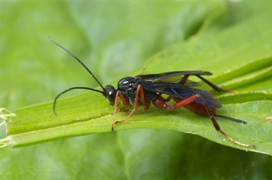A common language to deliver biodiversity knowledge to the world
Release Date 19 November 2010

Photographs of some species in the Catalogue of Life are available on Flickr
A crucial project to protect and preserve the world's biodiversity has been launched at the University of Reading.
Organisations across the globe have agreed to interlink and harmonise their differing catalogues of species as part of the i4Life (Indexing for Life) programme. The project aims to use a common language among seven of the world's data providers.
The catalogue of species, The Catalogue of Life, created by Species 2000 at the University of Reading with ITIS in Washington D.C, will be used as a yardstick. The Catalogue of Life is the most complete and integrated species list known to man. It has more than 90 databases feeding into an inventory of 1.3 million species of plants, animals, fungi and micro-organisms.
Dr Alastair Culham, of the University's School of Biological Sciences, said: "Whether you are looking for DNA sequences, distribution patterns or conservation status, the shared catalogues will help you to find the same plant, animal, fungus or micro-organism under the same name in each place. Harmonisation of these catalogues is fundamental to the organisation of knowledge that underpins the science, conservation and sustainable use of the world's biodiversity."
The target is to enable each programme to enhance its catalogue with the assistance of the others, and to create a harmonised list for the entire set of organisms.
The global programmes taking part are:
- 1) The European Nucleotide Archive based at EBI EMBL - European Bioinformatics Laboratory (part of the International Nucleotide Sequence Database Collaboration) and the ESFRI ELIXIR Infrastructure.
- 2) The Global Biodiversity Information Facility (GBIF) based in Copenhagen
- 3) The Barcode of Life Programmes through ECBOL partners in Warsaw and Utrecht, and CBOL and iBOL partners in Washington D.C., USA and Guelph, Canada.
- 4) The IUCN Red Data List Programme through IUCN Headquarters in Gland, Switzerland
- 5) The new LifeWatch ESFRI Infrastructure for Europe, through the Berlin Botanic Garden and Museum
- 6) The Encyclopedia of Life based in Washington D.C., USA
- 7) The Catalogue of Life Programme based at University of Reading
The Catalogue of Life is produced through the international Species 2000 organisation and includes synonyms and a structured taxonomic hierarchy.
The project, launched today (19 November), is funded by the EC e-Infrastructures Programme of DG-INFSO and led by Dr Alastair Culham and Professor Frank Bisby at the University of Reading. It will operate as a Virtual Research Community. New workflows and software will be developed by ETI Bioinformatics, Amsterdam, Cardiff University and University of Reading.
Taxonomic specialist support is provided by the Species 2000 array of more than 90 expert database custodians organised through the University of Reading and the Museum National d'Histoire Naturelle Paris.
ENDS
For more information please contact Rona Cheeseman, University of Reading press officer, on +44 (0)118 378 7388 or email r.cheeseman@reading.ac.uk
Notes to editors
The Catalogue of Life:
Co-ordinated by the international Species 2000 organisation based at University of Reading, and the Integrated Taxonomic information System (ITIS) based in Washington DC. It is widely used by major global and regional biodiversity portals. The intergovernmental Global Biodiversity Information Facility (GBIF) www.gbif.org and the Encyclopedia of Life (EoL) www.eol.org rely on it as the bedrock of their taxonomic information.
More information at www.sp2000.org and www.itis.gov
The 4D4Life Project:
The Catalogue of Life has started a second phase of development with the 4D4Life Project, funded by the European Union. This will install a new array of public services, design new service-based electronic architecture and extend the reach of the programme to link with Regional Centres in China, Australia, New Zealand, Brazil, North America and Europe, making important progress towards completing the Catalogue of Life at the world scale.